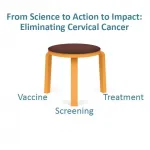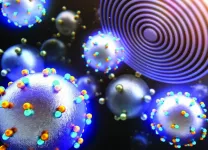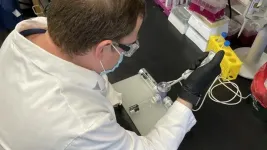(Press-News.org) Amsterdam, March 4, 2021 - Cervical cancer is a serious global health threat which kills more than 300,000 women every year. It's a disease that disproportionately affects women in low- and middle-income countries in equatorial Africa, Latin America and Southeast Asia, yet it is a preventable disease and decades of research have produced the tools needed to eliminate it.
Recognizing this urgent public health issue, the editorial team of Preventive Medicine, led by Editor-in-Chief Dr. Eduardo Franco, Director, Division of Cancer Epidemiology and Chair, Gerald Bronfman Department of Oncology at McGill University, is publishing a special issue titled "From Science to Action to Impact: Eliminating Cervical Cancer," which outlines the required courses of action to eliminate cervical cancer.
The journal's publication coincides with International HPV Awareness Day on March 4 and is dedicated to the more than half a million women who are struck by cervical cancer every year. Its publication follows the official launch last November of the World Health Organization (WHO) strategy to accelerate the elimination of cervical cancer. The strategy outlines targets for all countries to achieve by the year 2030: 90 percent human papillomavirus (HPV) vaccination coverage to prevent the infections that cause cervical cancer; 70 percent screening coverage; and 90 percent access to treatment for women identified with cervical disease.
Dr. Anna Giuliano and Dr. Linda Niccolai, two giants in the field of cervical cancer prevention research, served as guest editors for the issue. Dr. Giuliano, Director of the Center for Immunization and Infection Research in Cancer and Professor in the Department of Cancer Epidemiology at the Moffitt Cancer Center, and Dr. Niccolai, Professor of Epidemiology, Yale School of Public Health, Director of the Connecticut Emerging Infections Program, and member of Yale Cancer Center, assembled an outstanding group of international scientists and practitioners who contributed papers on basic science, clinical medicine, public health practice and mathematical modeling, all focused on the targeted action needed in each of these realms to achieve cervical cancer elimination.
"In the history of medicine, we never dared to conjugate the verb 'eliminate' with respect to cancer," says Dr. Franco. "The toll in human suffering for a disease that is preventable makes the elimination of cervical cancer a moral goal that we have an ethical obligation to achieve. HPV vaccination can prevent the vast majority of cervical cancers and molecular HPV testing is a great technology to detect the remaining precancerous lesions that are not prevented. These two preventive strategies must be deployed on a global scale."
In their editorial, Drs. Giuliano and Niccolai emphasize that in addition to public health and clinical resources for research and health care, there is a critical need for government officials to take a strong stand. "We have all the tools we need for cervical cancer elimination: vaccination, screening and treatment, for both primary and secondary prevention," says Dr. Niccolai. "What we need now is the commitment of political, medical and public health officials to make this happen."
Dr. Giuliano further explains, "The articles in this issue were selected to encapsulate the knowledge we have, and effort needed to reach global cervical cancer elimination. Our intent was to inspire action globally among scientists, health care providers, policy leaders and communities to accelerate progress toward this attainable goal."
The COVID-19 pandemic has created both challenges and opportunities regarding global efforts to conduct HPV screening and vaccination. "The pandemic has taught us how to be agile and creative, and how to work toward health promotion under the most difficult of circumstances. It has forced us to reimagine how we deliver health care including preventive services," says Dr. Niccolai. "It has also highlighted for the public the powerful potential of vaccines to protect our health."
"We are delighted to place Preventive Medicine, a respected journal that has an international readership in public health, to the service of this great cause," says Dr. Franco, who has served as Editor-in Chief since 2013. "Drs. Giuliano and Niccolai have done an outstanding job. This special issue of the journal presents a technically feasible and realistic roadmap for facing the great challenge of eliminating cervical cancer."
INFORMATION:
Researchers at the Earlham Institute (EI) have created a new automated workflow using liquid handling robots to identify the genetic basis to prevent plant pathogens, which can be used on a much larger and rapid scale than current methods.
The new EI Biofoundry automated workflow gives scientists an enhanced visual check of genetic mutations linked to the control of crop disease, speeding up analysis to a fraction of the time compared to current methods - from months to weeks - accelerating development of novel products for crop protection in the agricultural industry.
Biosynthesis is the formation of chemical compounds by a living organism, ...
COSMIC, a multipurpose X-ray instrument at Lawrence Berkeley National Laboratory's (Berkeley Lab's) Advanced Light Source (ALS), has made headway in the scientific community since its launch less than 2 years ago, with groundbreaking contributions in fields ranging from batteries to biominerals.
COSMIC is the brightest X-ray beamline at the ALS, a synchrotron that generates intense light - from infrared to X-rays - and delivers it to dozens of beamlines to carry out a range of simultaneous science experiments. COSMIC's name is derived from coherent scattering and microscopy, which are two overarching X-ray techniques it is designed to carry out.
Its capabilities include ...
WASHINGTON (March 4, 2021)--Over the next month, 209 U.S. counties in the United States will need to implement crisis workforce strategies to deal with potentially dangerous shortfalls of intensive care unit doctors, according to a new analysis published today. The analysis draws on data from a just launched county-level hospital workforce estimator, one that takes into account the strain on staffing due to the COVID-19 pandemic.
"The shortages could occur just as public health officials warn that variants of the coronavirus are spreading in the United States and could trigger a sharp rise in the number of Americans infected," Clese Erikson, the principal investigator on the project and deputy director of the ...
An innovative cell-based treatment for cancer has been found promising for the control of infections caused by fungi. A study published in the journal Cytotherapy reports that the use of CAR (chimeric antigen receptor) T-cells programmed to “recognize” Cryptococcus spp. fungi was effective in combating infection in vitro and in mice.
C. gattii and C. neoformans are present in soil with dead organic matter and places contaminated by the droppings of pigeons and other birds. They cause systemic mycoses in the human organism. They can infect the lungs and central nervous ...
With a relatively minor genetic change, a new treatment developed by researchers at the Georgia Institute of Technology and Emory University appears to stop replication of both flu viruses and the virus that causes Covid-19. Best of all, the treatment could be delivered to the lungs via a nebulizer, making it easy for patients to administer themselves at home.
The therapy is based on a type of CRISPR, which normally allows researchers to target and edit specific portions of the genetic code, to target RNA molecules. In this case, the team used mRNA technology to code for a protein called Cas13a that destroys parts of the RNA genetic code that viruses use to replicate in cells in the lungs. It was developed by researchers in ...
UNIVERSITY PARK, Pa. -- While women can be drawn into farming for many reasons, researchers in Penn State's College of Agricultural Sciences have found that female-owned farms in the U.S. are more common in areas that are closer to urban markets, that engage in agritourism activity, and that offer greater access to childcare.
The number of farms operated by women has risen over the past two decades, said Claudia Schmidt, assistant professor of marketing and local/regional food systems.
The U.S. Department of Agriculture changed the way it counts the operators of farms in its most recent Census of Agriculture, allowing for up to four principal operators per farm. This has inflated the number of ...
COVID-19 is only the latest infectious disease to have had an outsized impact on human life. A new study employing ancient human DNA reveals how tuberculosis has affected European populations over the past 2,000 years, specifically the impact that disease has had on the human genome. This work, which publishes March 4 in the American Journal of Human Genetics, has implications for studying not only evolutionary genetics, but also how genetics can influence the immune system.
"Present-day humans are the descendants of those who have survived many things--climate changes and big ...
To succeed in mating, many male frogs sit in one place and call to their potential mates. But this raises an important question familiar to anyone trying to listen to someone talking at a busy cocktail party: how does a female hear and then find a choice male of her own species among all the irrelevant background noise, including the sound of other frog species? Now, researchers reporting March 4 in the journal Current Biology have found that they do it thanks to a set of lungs that, when inflated, reduce their eardrum's sensitivity to environmental noise in a specific frequency range, making it easier to zero in on the ...
Brain cells called astrocytes derived from the induced pluripotent stem cells of patients with bipolar disorder offer suboptimal support for neuronal activity. In a paper appearing March 4th in the journal Stem Cell Reports, researchers show that this malfunction can be traced to an inflammation-promoting molecule called interleukin-6 (IL-6), which is secreted by astrocytes. The results highlight the potential role of astrocyte-mediated inflammatory signaling in the psychiatric disease, although further investigation is needed.
"Our findings suggest that IL-6 may contribute to defects associated with bipolar disorder, opening new avenues for clinical intervention," says co-senior study author Fred Gage ...
New collaborative research from Northwestern University and Lund University may have people heading to their backyard instead of the store at the outset of this year's mosquito season.
Often used as an additive for cat toys and treats due to its euphoric and hallucinogenic effects on cats, catnip has also long been known for its powerful repellent action on insects, mosquitoes in particular. Recent research shows catnip compounds to be at least as effective as synthetic insect repellents such as DEET.
But until now, the mechanism that triggered insects' aversion to this common member of the mint family was unknown. In a paper ...




